Xu Beihong, Jamini Roy, and a Possible Crossroad of Indian & Chinese Modernism
The title of this note requires some explanation. Xu Beihong (Ju Peon) is widely regarded as the father of Chinese Modernism, while Jamini Roy is known as the father of Indian Modernism. (12) The works under discussion come from the estate of Jamini Roy, yet are believed to be by Xu Beihong, hence the framing as a “Tale of Two Fathers.”
Xu Beihong visited India in 1939–40 (41?), during which he held two exhibitions: one at Santiniketan and another in Calcutta, marking a crucial India–China cultural exchange. (11)
This research has taken over two years in fits and starts. We are now releasing it into the public domain to invite further feedback and for critical engagement. Attributions of this nature must be approached with caution; after all, we are proposing misattribution in not one but three artworks.

Our goal is twofold: first, to potentially add more works to Xu Beihong’s Santiniketan / Calcutta oeuvre; and second, to highlight a possible collaboration that underscores a significant moment in cultural history.
Research Notes
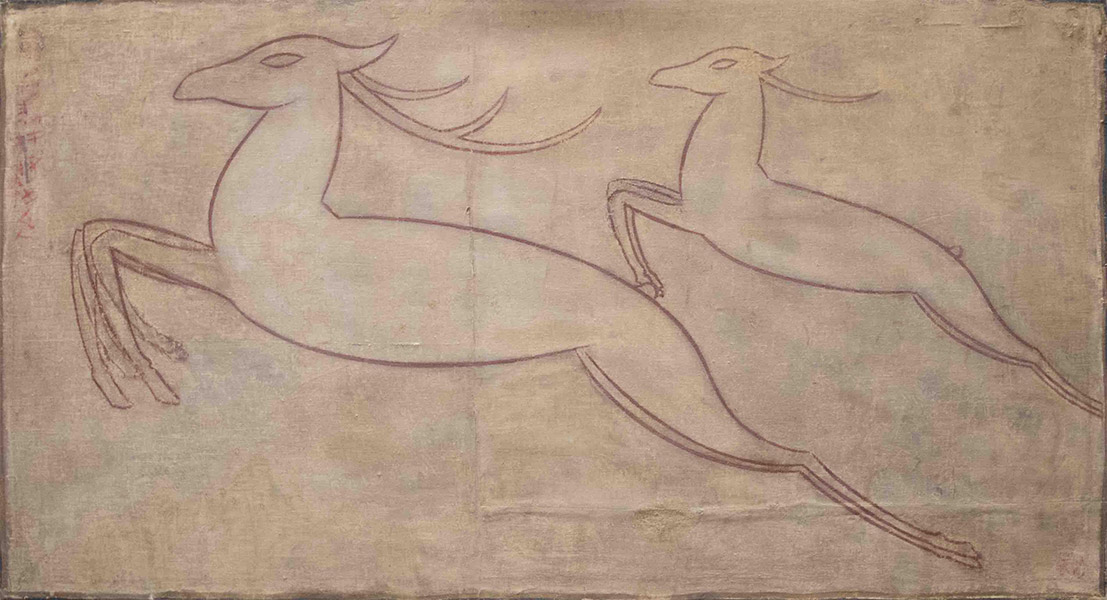
1. 24 x 46 inches, On Cloth, Signature upper left with Seal lower right, Provenance: Dhoomimal
The symbolism of deer and antlers (1,2,3) and indeed the recurring motif of “two” (double happiness, yin-yang, harmony and balance) is rooted in Chinese tradition.
The very thick neck of the deer and the antlers possibly imply the “dragon-spirit”. The artist was known for patriotic resistance during the Sino-Japanese wars. (4)
The simplification down to a single, flowing line in this work is likely inspired from Jamini Roy. However, this is also very much a part of Chinese calligraphy. This can be a exploratory work ? Similar explorations of Jamini Roy’s new style were made by Gao Jianfu almost a decade earlier. (14,20)
Among Jamini’s key contributions was the transformation of folk figures from the three-dimensional into modernist (somewhat abstract), two-dimensional forms, often with a shadow line showing the volume. Hallmarks of his style include floating eyes, elongated figures, and compositional elements such as the cat fractured into left and right views. As Partha Mitter has noted, Roy’s abstraction is comparable in significance to Piet Mondrian’s (5), where, for example, water waves are abstracted to simple lines and so on. He created a unique language of volume-less folk abstraction. His new language inspired many!
The artwork is on cheap cloth available in Calcutta at the time, and also used by Jamini Roy. This was a politically challenging time with countries preparing for war. Canvas would not have been readily available.
This work has a published provenance (10), found in the archival book of the oldest gallery in India, Dhoomimal. We note a portrait dated 1954 of Ram Babu, the proprietor of Dhoomimal, and made by Jamini Roy - the relationship was an old one. On Jamini’s death in 1972, reference collections were (further) built up at Dhoomimal, the National Gallery of Modern Art, and the Calcutta Information Center. Debabrota Roy, the oldest of the grandsons, had helped in this dissemination and has been acknowledged in writing by NGMA for the same, as Amiya Roy (Jamini Roy’s eldest son and assistant) had Parkinson's and passed away within a few years of Jamini’s passing. The dragon-deers carries Debabrota's “handing over” signature verso as is also seen in some other works.
Generally, in attributing these older works, finding a provenance chain is extremely difficult; here, we were fortunate.
The misattribution is understandable. The works came from Jamini’s Estate post his death. The single-line execution of form, the use of the cotton (saree) cloth, all possibly contributed to the misattribution.
What has been overlooked is the signature on the upper left and the seal on the lower right in one of the works. The geese artworks are certainly not in Jamini's style and that there is no record of ever using calligraphic paper.
The seal is somewhat indistinct - photography and inspection in red light provided a clearer picture from which the signature in black was extracted.
We refer to two seals used ELSEWHERE by Xu Beihong and use that to translate the signature in this particular painting.
The first circle I believe is Bei and the second circle is Hong in the seal below. Compare to the signature on the artwork.
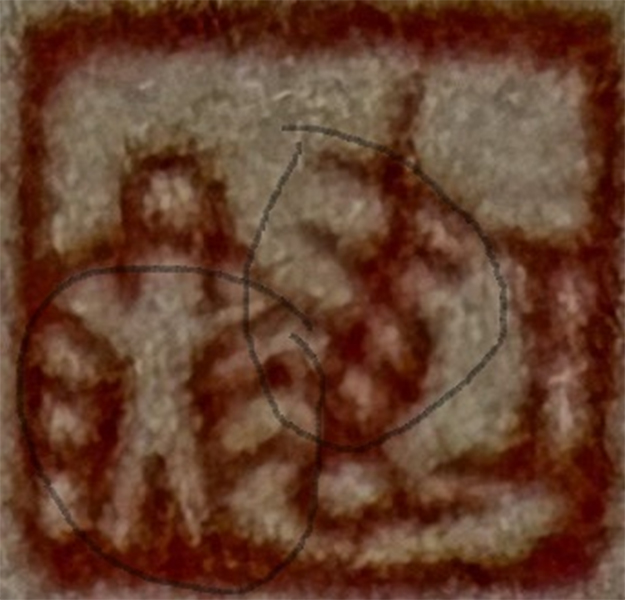
Xu Beihong Seal.
Another Xu Beihong seal used elsewhere is below, wherein the first vertical line is Bei Hong (I believe). One can make out that “Hong” is a combination of two parallel line type structures as seen in the signature.
.jpg) Xu Beihong Seal 2.
Xu Beihong Seal 2.
The signature is cursive seal calligraphy. Note the material of the painting - cheap cloth; the coarse nature of the cloth creates its challenges. It is not possible to easily write elaborate signatures on this cloth.
Jamini would not have known seal calligraphy - there is no indication of such knowledge.
Xu Beihong was a calligrapher, and the ability to make long strokes would be second nature, as we see in the artwork. There are quite a few corrections in the lines. It feels as if the galloping/prancing dragon-deers with antlers would be Xu Beihong’s concept but implemented in Jamini’s minimalist style.
Translation is not easy. Calligraphy is contextual.
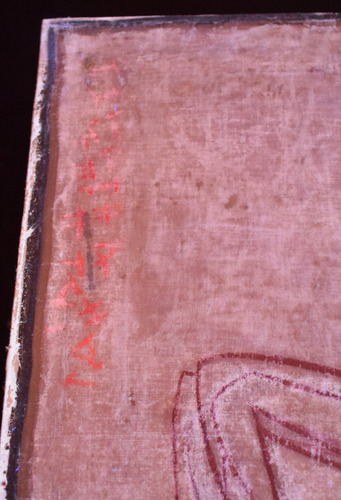
.jpg)
Compare the "Bei" and "Hong" in the signature above to those in the seals.
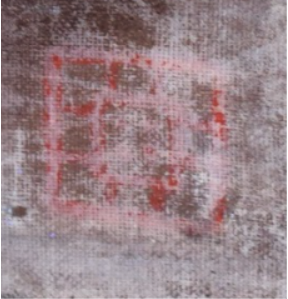
Seal on the two deers artwork, ~2.5 X 2.5 cm.
_(1)_(1).png)
Seal on the two deers artwork inspected with photography and under red light.
We are not able to find any reference to this seal in the two published books on Xu Beihong that we have. He used over 200 seals, many of which were made for him by others, and presumably not all are documented.
The seal is a carved (seal cutting), which Jamini never had or used. In some instances, where Jamini did add a seal, it was painted and somewhat tentatively drawn.
The other two “geese” artworks are more in the style of Xu Beihong (15). Interestingly, the name “Beihong” means “sorrowful goose”. Again, the recurring motif of “Two”.

2. Two Geese on calligraphy paper stuck on cloth, 32 x 20 inches, Provenance: Dhoomimal. The calligraphy paper was the beginning point of the research as there are no (other) works by Jamini on calligraphy paper !
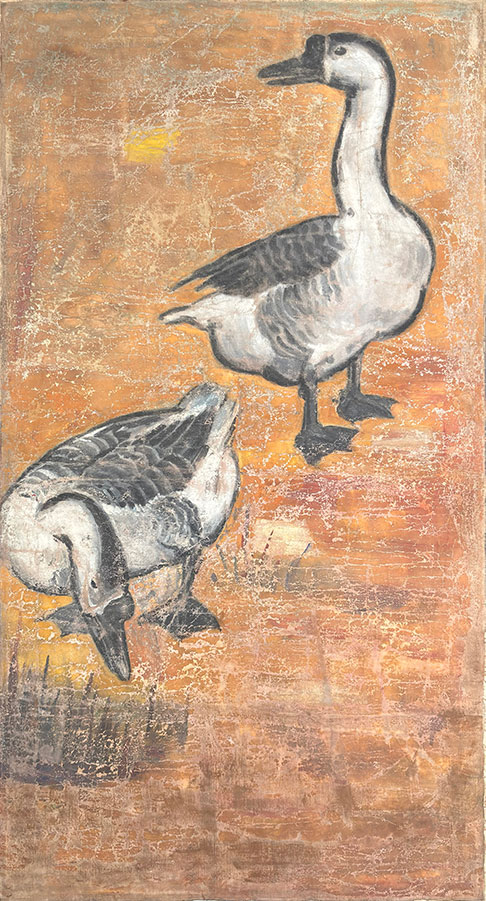
3. Two Geese, background is tempera on cloth, 41 x 21 inches. (16)
These “Two Geese” works have both seen some damage. The seal and signature do not appear to exist. The damages have not been restored to keep the artworks pristine for further research and analysis. These works may be unsigned - there are other artworks done in the same period by Xu Beihong without a seal or a signature.
There is no work of Jamini recorded on calligraphic paper. This was in fact the starting point of the research.
Penti Menti
The deer work shows multiple areas of Penti Menti, implying this was likely the FIRST of such an artwork, the first experiment. We observe changes in the foreleg section of both deer. There is erasing. The change in the upper torso of the second deer.
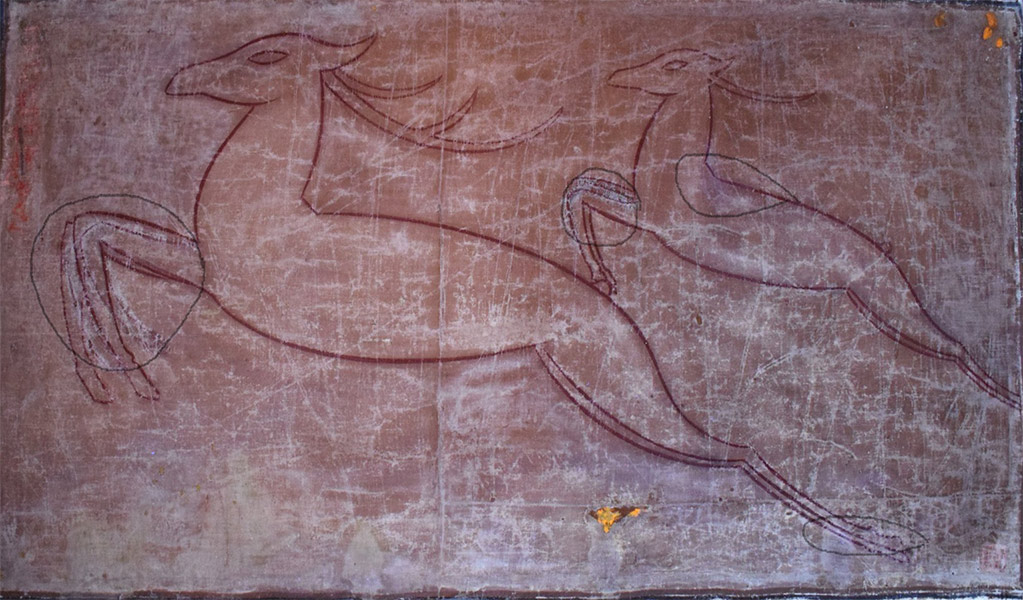
Penti Menti under Conservation Light
“Artistic Experiments/Versions” indicate the existence of an original artwork
There are various prints by (after) Henry Singleton showing the surrender of Tipu Sultan. The prints were created with the original artwork as a reference. Thus indicating the presence of the original painting somewhere.
The same argument was used in the identification of Leonardo’s Salvatore Mundi. There exist at least 20 artworks, experimental copies of Salvatore Mundi, that various artists made over the next couple of centuries from when the original was painted. These experimental copies imply the existence of the original, which had been missing for over a hundred years until its discovery. Note here that when we inspired versions ; we suggest an artist creating his version of another painting, and with his signature as a study or an experiment. (7)
... consisting largely of small copies of larger works, be regarded as the exercises of one learning…
-Alfred Watson on Jamini Roy 1929 Exhibition
Jamini conducted numerous experiments and made many such inspired works mostly in small format - of Picasso, Van Gogh, Rembrandt, Impressionism(19), Australian bark paintings, Cezanne, Byzantine mosaic, and others.
Jamini made his own version of the Deer/Dragon Spirit. This deer image below has Jamini’s classic shadow (double lines denoting dimensionality) and the floating/large eyes - clearly identifiable as a Jamini. The girth of the neck and torso also reduces. The background is classic Jamini. Signed Jamini lower right.

Jamini Roy, two deers.
An inspired version of Geese by Jamini exists, and again in a small format. The background in the artwork is also clearly identifiable as a Jamini.

Jamini Roy, Goose, Signed Jamini Roy Lower Right in Bengali.
The Jamini Geese differ significantly in execution, with notable features including the absence of talons in the feet, distinct foot morphology, a distinctly angular tail, an odd way the feet meet the body, the redone bottom-back, and others. The background of the work is very much Jamini and in a small format (feels 10 x 7 in). It is signed. The other two “Geese” works under discussion are different.
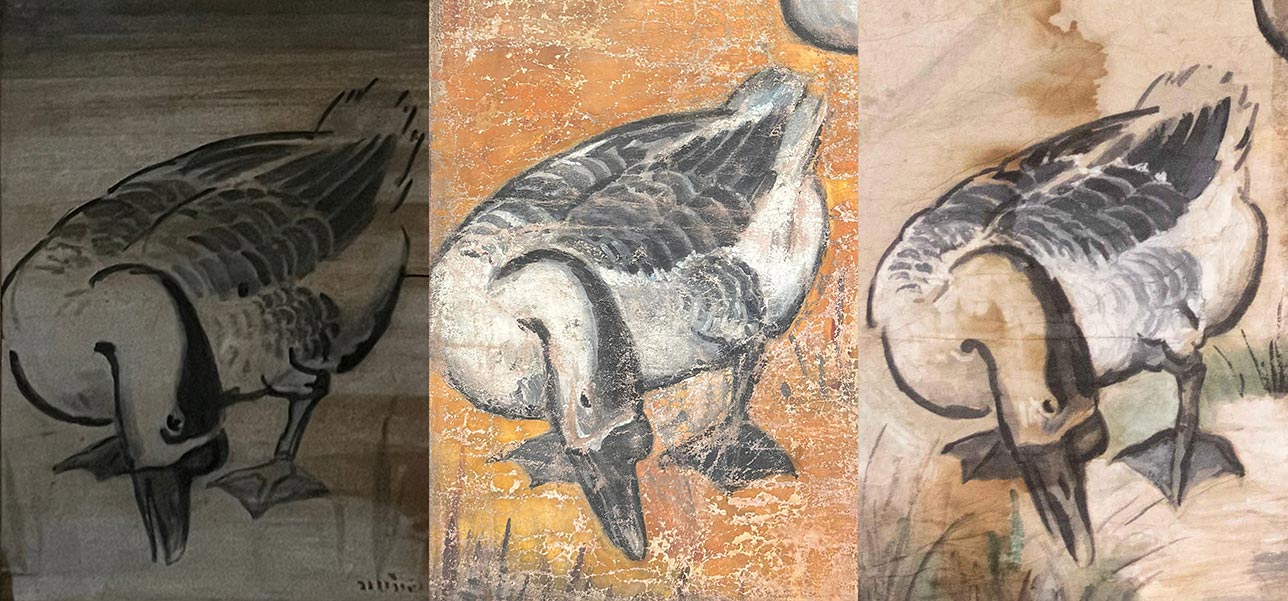
Comparing the three geese.
Preparatory sketches by Jamini Roy
There must be close to 200 such documented sketches on paper. Not a single one shows any deer in this style/dragons or geese. Jamini’s own version of the deer! (17)
1939/40 was an exploratory period for Xu Beihong
Xu Beihong is known for his Galloping Horses.
.jpg)
Xu Beihong, Galloping Horse.
The galloping deer/dragon spirit likely stems from this.
Santiniketan/ Calcutta was a time for experimentation for Xu Beihong. Xu Beihong’s masterpiece “The Foolish Old Man Who Moved a Mountain” was made in paper during this time in Santiniketan with ink and later recreated in color.

Study Made in 1940 (Calcutta) for “The Foolish Old Man Who Moved a Mountain”. Image Credit (20)
In Kalimpong, Xu Beihong rode horses and gained a new appreciation for these animals on a firsthand basis. They say that after this experience, his horses had more elongated legs. Interestingly, the man who called Jamini Roy the father of Indian Modernism, MF Husain, himself met with Xu Beihong in China in 1951 and was reportedly inspired by Xu Beihong’s horses! (13)
Xu Beihong & Jamini Roy - An Artistic Relationship?
We have not been able to find much from that period. Research is still underway. Here we present some possibilities.
What we do know is that Jamini Roy had an exhibition in 1937 at the Indian Society of Oriental Art (Abanindranath Tagore founded the Institution). This was a superbly successful exhibition - Jamini had reached the peak of his commercial success during this period and for the next decades. His studio was being visited by Rabindranath Tagore, Marie Casey (Bengal Governor’s wife), his exhibitions critiqued by Shahid Suhrawardy, and so on - he was at his peak.
Ju Peon (Xu Beihong) held his Calcutta exhibition in 1940 at the same venue (Indian Society of Oriental Art), and the exhibition was opened by Abanindranath Tagore (Jamini Roy’s mentor and professor at the Govt College of Art)
Xu Beihong was in Calcutta / Santiniketan for two years (left India in December 1941? (18)) Its a foregone conclusion that they would have met. The specifics are not known. Xu Beihong’s whereabouts after his Calcutta exhibition are mostly unknown (missing for a whole year?) - Aside from references to spending some time in Kalimpong and Darjeeling.
Jamini Roy has created several China-inspired artworks. The second work interestingly is a Chinese dragon (faded/degraded sign lower right).
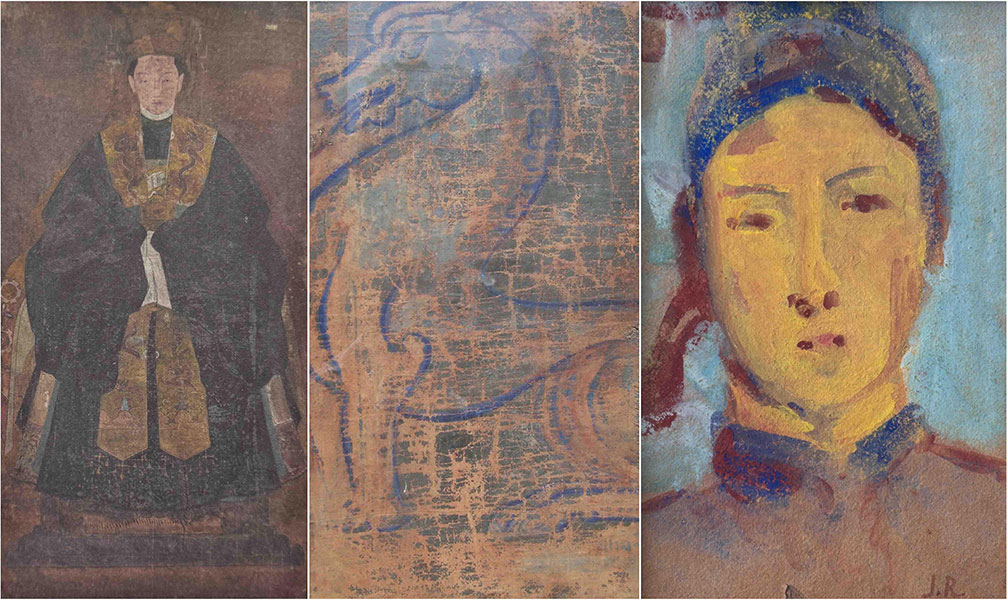
Jamini Roy's China-inspired artworks.
We also see an invitation by the Chinese embassy to Jamini Roy in 1959.

Invitation from the Chinese Embassy to Jamini Roy in 1959.
In 1939-40, Jamini was at the peak of his artistic career. This peak continued for a couple of decades. However, one does not see many photographs of him at (say) show openings at the Academy of Fine Arts and other places. He had even made the then Bengal governor’s wife visit his studio instead of obliging her with a visit. He was clearly not seeking publicity. Xu Beihong may not have been well-known in India's journalistic circles. In addition, the period was marked by numerous geopolitical developments, and everyone's attention was focused on these. We see the interaction between another Chinese artist, Gao Jianfu, and Jamini Roy also missing in the archives (14). We are continuing our search in newspaper archives and libraries on this matter.
Summary
In summary, we have one signed work with a published and impeccable provenance. The style seems exploratory.
We have two other artworks very much in the style of Xu Beihong - one of them being from the same impeccable provenance as above and another from an older reference source and photographed in front of Indian art world legends.
After having written this research note, we had an ‘aha’ moment - we understood why this mis-attrbution happened. There are a few reasons.
Xu Beihong used the name Ju Peon in India. Post-1949, there seems to have been a total paucity of artist visits from China, shifting the focus away from the Indo-Chinese cultural ties of the past. Jamini made his own versions of many international art and international artists, but this art was generally continents away. Jamini would certainly not have an original Monet or Cezanne in his house even though he made his own inspirations of them. But Xu Beihong was in Calcutta ! This has totally been overlooked - of course, till now Xu Beihong's India journey and the artist himself have been overlooked in India. It only came to people’s attention in (very) recent times (in India) due to visits by Xu Beihong's daughter, the Chinese Ambassador to Santiniketan, the gifting of a Xu Beihong print to the Chinese Premier by the Indian PM, and so on.
The good news is that the cultural connections have re-booted.
References
1 - Two Paintings of Deer Antlers, Qianlong Emperor, Met Museum
2 - Phoenix Kingdoms International Symposium, Guolong Lai, Professor of Liberal Arts, Westlake University “What is the So-called ‘Tomb Guardian Figure’?” (on Antlers)
3 - Qing Dynasty “Deer” Porcelain Vases
4 - “Xu's passionate images of horses, a traditional symbol of Chinese martial spirit, were intended to inspire patriotic resistance during the Sino-Japanese War (1937–45)” (The Met)
5 - Collapsing Certainties, Reflections on the End of the History of Art by Partha Mitter ; Discussion with Partha Mitter
6 - Xu Beihong, Pioneer of Modern Chinese Painting, Denver Art Museum & Xu Beihong Memorial Museum, pg 127
7 - “Copies (of the Salvatore Mundi)” by Dianne Modestini (the restorer of Leonardo’s artwork)
8 - Xu Fangfang, Galloping Horses, Artist Xu Beihong and His Family in Mao’s China
9 - The Pleasures of Chinese Calligraphy, The Met - Robert Harris on Seal, Cursive, and Clerical calligraphy - Youtube
10 - Jamini Roy, Uma, Ravi & Ram Babu Estate - Dhoomimal Gallery, pg 60

11 - Ju Peon 1940 Exhibition Catalogue PDF @ prinseps.com
12 - MF Husain
13 - Institute of Chinese Studies, New Delhi, Special Lecture: Artist Xu Beihong and His Family in Mao’s China by Xu Fangfang
14 - Ignoring the Elephant In The Room - Interactions between Gao Jianfu & Jamini Roy
15 - Sotheby's 5 October 2007, Lot 244
.png)
16 - Masanori Fukuoka (Standing) of Glenbarra Art Museum, Seated Ganesh Pyne, Paritosh Sen. Circa 1995. Pundoles Glenbarra Auction Catalogue February 2022
.png)
17 - Jamini Deer? Sketch
.png)
18 - Dr. Ritwij Bhowmik, "Xu Beihong and India: An Alliance Never Explored", International Journal of Arts, Humanities and Management Studies, vol. 1, no.4, 2015
19 - - Impressionism study by Jamini Roy - small format
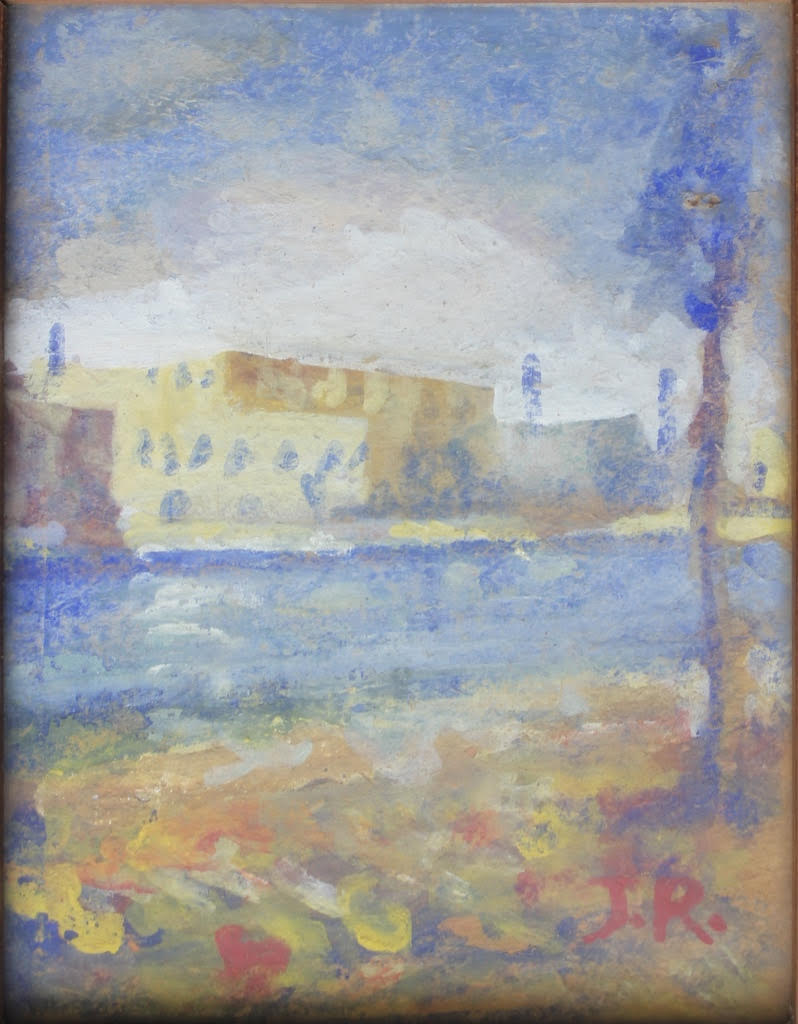
20 - Amitava Bhattacahrya, Survey of Sino-Indian Artistic Discourse, Liu Weiming discussion (Maulana Abul Kalam Azad Institute of Asian Studies, 2014)